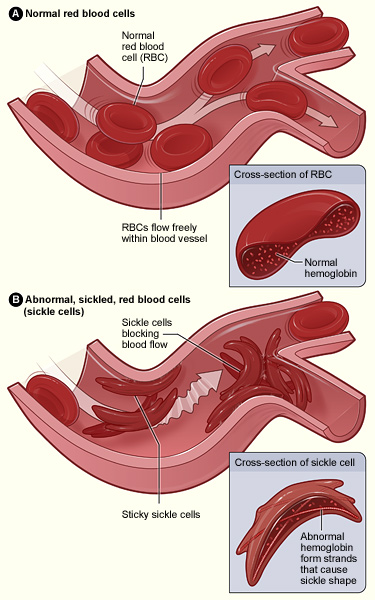Sickle cell crisis, a severe complication of sickle cell disease, demands immediate medical attention.
Clinical Case Presentation of Sickle Cell Crisis
a 10-year-old child presented with sudden, severe pain in the legs and arms, accompanied by fever and fatigue. This was preceded by multiple episodes of vomitting and loose stools.
The child has a known history of sickle cell disease. Physical examination reveals swelling in the hands and feet. Blood tests confirm low hemoglobin levels and the presence of sickle-shaped cells (Sickling).
What is Sickle Cell Crisis?
A sickle cell crisis is a painful episode that occurs when sickled red blood cells block blood flow in small vessels, depriving tissues and organs of oxygen. These crises are a hallmark of sickle cell disease and can vary in frequency and severity.

Causes
Sickle cell crisis can be triggered by various factors, including:
- Dehydration: Lack of sufficient fluids can lead to sickling of red blood cells.
- Infection: Illnesses can increase the risk of crises.
- Extreme temperatures: Both cold and heat can precipitate a crisis.
- Stress: Physical or emotional stress can trigger an episode.
- High altitude: Low oxygen levels can exacerbate the condition.
Signs and Symptoms
Sickle cell crisis presents with various symptoms, including:
- Severe Pain: Often in the chest, back, arms, and legs.
- Swelling: Particularly in the hands and feet.
- Fever: Sometimes accompanies the pain.
- Shortness of Breath: Due to reduced oxygen delivery.
- Fatigue: A result of chronic anemia.
Risk Factors
Several factors can increase the likelihood of experiencing a sickle crisis:
- Genetics: Inheriting the sickle cell gene from both parents.
- Age: Crises often start in early childhood.
- Environment: Living in or traveling to high altitudes.
- Inadequate Hydration: Failing to drink enough fluids regularly.
- Infections: Frequent or severe infections can trigger crises.
Diagnosis
Diagnosing a sickle cell crisis involves several steps:
- Patient History: A thorough review of symptoms and medical history.
- Physical Examination: Checking for signs of pain, swelling, and infection.
- Blood Tests: Identifying sickle-shaped cells and measuring hemoglobin levels.
- Imaging: Using X-rays or MRI to assess for complications like acute chest syndrome.
Treatment
Managing a sickle crisis requires a multifaceted approach:
- Pain Management: Utilizing medications like NSAIDs, opioids, and hydration.
- Oxygen Therapy: Administering oxygen to improve blood oxygen levels.
- Hydration: Intravenous fluids to reduce blood viscosity and prevent further sickling.
- Infection Treatment: Antibiotics if an infection is present.
- Blood Transfusions: To increase the number of normal red blood cells.
Complications
Sickle crisis can lead to several complications:
- Acute Chest Syndrome: A severe lung condition that mimics pneumonia.
- Stroke: Due to blocked blood flow to the brain.
- Organ Damage: Chronic lack of oxygen can damage organs like the liver, kidneys, and spleen.
- Priapism: Painful, prolonged erections due to trapped sickle cells in the penis.
- Gallstones: From the breakdown of red blood cells.
Conclusion
Sickle cell crisis is a serious condition requiring prompt and comprehensive care. With proper management, individuals with sickle cell disease can lead healthier lives despite the challenges posed by this condition.
Read more:

